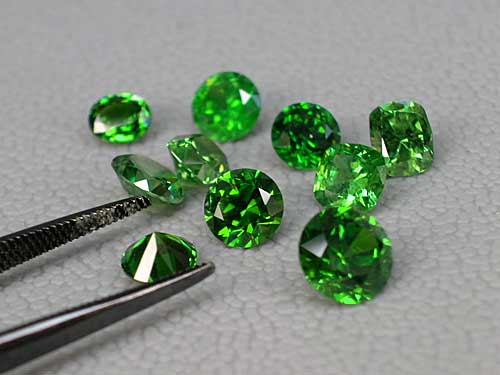|

By Richard
W. Hughes
Introduction/Name
Demantoid
is the name given to the rich green variety of andradite garnet. The
gem was first discovered in Russia and the name is derived from its
diamond-like adamantine luster.
Color
While
the color of demantoid never equals that of the finest emerald, an
emerald-green is the ideal. The color should be as intense as possible,
without being overly dark or yellowish green. The color of demantoid
is believed to be due to chromium. It should be noted that demantoid’s
fire is best seen in the lighter, less saturate gems. Thus the color
preference is a matter of individual taste. Some people will choose
an intense body color and less fire, while others prefer a lighter
body color and more fire.
 |
| Ural Pearls. A bevy of beauties
from the Ural Mountains in Russia. Demantoid such as this has
not been seen since the time of the Czars. The cut stones are
over 4 cts. each. Photo: Jeff Scovil/Pala International |
|
Lighting
Demantoid
garnet generally looks best under daylight. Incandescent light makes
it appear slightly more yellowish green. Because of its high dispersion,
demantoid looks great in the same type of lighting as diamond, i.e.,
multi-point (as opposed to diffuse) lighting.
Clarity
In
terms of clarity, demantoid is relatively clean. Thus when buying one
should expect eye-clean or near-eye-clean stones. Demantoids often
contain radiating needle inclusions that are termed “horsetails.”
 |
| A classic example of a horsetail inclusion
in a Russian demantoid garnet. Photo: Wimon
Manorotkul |
|
Cut
In
the market, demantoids are found mainly as round brilliant or cushion
cuts. Cabochon-cut demantoids are not often seen.
Prices
Demantoid
is among the most expensive of all garnets, with prices similar to
those fetched by fine tsavorite (the other green garnet). But like
all gem materials, low-quality (i.e., non-gem quality) pieces may be
available for a few dollars per carat. Such stones are generally not
clean enough to facet. Prices for demantoid vary greatly according
to size and quality. At the top retail end, they may reach as much
as US$10,000 per carat.
Stone Sizes
Demantoid
is rare in faceted stones above 2 cts. Fine demantoids above 5 carats
can be considered world-class pieces. Most stones tend to be less than
1 ct.
Sources
The
original locality for demantoid was in Russia’s Ural Mountains.
Today, deposits of lesser material exist in Iran, Italy and Namibia,
but the Russian material remains the standard by which the gem is judged.
Enhancements
Some
demantoid garnet is heat-treated to improve the color. The resulting
stones are stable under normal wearing conditions.
Imitations
Demantoid
garnet has never been synthesized, but a number of imitations exist.
These include green glass and green YAG.
 |
| This
suite of 0.75–2.0 ct. demantoid garnets shows the typical
range of colors possible. The ideal body color would be the center
stone, which is not too light or dark, but the lighter tones show
off demantoid's fire to better effect. Photo: Wimon
Manorotkul; Gems: Pala International |
|
Properties
of Demantoid Garnet
| |
Demantoid
Garnet (a variety of andradite garnet) |
| Composition |
Ca3Fe2(SiO4)3 |
| Hardness
(Mohs) |
6.5
to 7 |
| Specific
Gravity |
3.84 |
| Refractive
Index |
1.888;
Singly refractive |
| Crystal
System |
Cubic |
| Colors |
Light to deep green |
| Pleochroism |
None |
| Dispersion |
0.057;
this is among the highest of all gems, even higher than diamond |
| Phenomena |
None |
| Handling |
Ultrasonic:
generally safe, but risky if the gem contains liquid inclusions
Steamer: not safe
The best way to care for demantoid garnet is to clean it with warm,
soapy water. Avoid exposing it to heat or acids |
| Enhancements |
Some
demantoid is heat treated to improve the color |
| Synthetic
available? |
No |
Further Reading
The Collector Gem Buying Guides
In addition to the above, please visit the Learning
Vault at Palagems.com for many additional articles on gems, minerals and mining.
|





